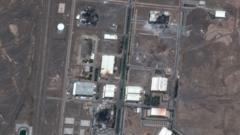The analysis reveals extensive destruction at the Natanz and Isfahan nuclear facilities following airstrikes believed to be orchestrated by Israel, as well as damage to missile bases across Iran.
Satellite Images Uncover Damage to Iran's Nuclear Facilities Amid Ongoing Strikes

Satellite Images Uncover Damage to Iran's Nuclear Facilities Amid Ongoing Strikes
Recent satellite imagery highlights significant damage to Iran's nuclear and military sites, prompting international concern.
Recent satellite imagery from reputable sources has unveiled alarming damage to vital Iranian nuclear and military sites, further escalating tensions in the region. The analysis primarily focuses on the notable Natanz nuclear facility and the missile site located south of Tabriz, both of which were reportedly struck in a series of military attacks last Friday.
Images released by Maxar Technologies illustrate clear damage at Natanz, specifically affecting the pilot fuel enrichment plant and a crucial electrical substation. According to the Institute for Space and International Security (ISIS), the overhead portions of the plant, which previously handled uranium enrichment up to 60% U-235, appear severely compromised. The International Atomic Energy Agency (IAEA) chief Rafael Grossi informed the UN Security Council that "the above-ground part of the pilot fuel enrichment plant has been destroyed," raising alarms over the potential consequences of such destruction.
Additionally, footage captured shortly after the strikes revealed multiple smoke plumes ascending from the facility, suggesting the use of advanced munitions. In an analysis by Justin Bronk of the Royal United Services Institute, the explosion patterns observed may align with the deployment of penetrating munitions, notably GBU-31 or GBU-28 "bunker buster" bombs, historically utilized by Israel to target fortified structures.
On the other hand, Grossi clarified that there remains no evidence of a direct attack on the subterranean cascade hall that houses the main enrichment plant. This situation is under surveillance as the IAEA reported that four essential buildings in Isfahan were damaged, which includes the Uranium conversion facility and a fuel plate fabrication unit. Verified analyses of the latest Maxar imagery indicated significant harm to at least two buildings within Isfahan, while the IAEA confirmed that no hazardous levels of radiation have emanated from either nuclear site.
Further inspections documented damage across other military facilities in Iran. Recent imagery from Umbra Space highlighted destruction at a missile complex near Tabriz, signifying damage to weapon storage locations, missile shelters, and silos. Additional low-resolution images from Kermanshah indicated extensive burn marks near a missile base, correlating with reported explosions in the area. Analyzed imagery also confirmed substantial damage to an Islamic Revolutionary Guard Corps (IRGC) ballistic missile base near Tehran and notable impacts on a radar site in the Piranshahr region.
As military operations continue, the geopolitical implications of these attacks are likely to reverberate, with global stakeholders closely monitoring developments.






















